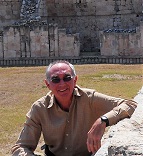


|
|
|
|||||||||||||||
|
|
||||||||||||||||
|
|
||
|
|
Kabah
Located 18 km south of Uxmal and connected to it by a raised pedestrian causeway 5 meters wide with monumental arches at each end is the city of Kabah: The connection between the two sites indicates its importance. It is thought that in early times Kabah and Uxmal were adversaries, but that they eventually became allies with Kabah becoming the second city in importance next to Uxmal. The ruins extend either side of the main highway although only a few of the buildings are open to the public there are many more still overgrown and covered with the forest including a large pyramid, although excavation work is under-way to carry out archaeological excavations and clear and restore more of the buildings.
The site consists of a number of palaces, low stone buildings, and step-pyramid temples and contains many sculpted panels, mostly depicting the site's rulers and scenes of warfare. The most famous structure at Kabah is the Kodz Poop which means “rolled-up matting” also known as the "Temple of the Masks". This stands on a low platform and has a façade decorated with 250 stone masks of Chaac, the long-nosed rain god. The temple is 46 metres long and contains 10 chambers arranged in two tiers of five built one behind the other. On the east façade are two well-preserved life-size stone sculptured figures. Located in the centre of the city is the Great Palace, one of the best-preserved buildings on the site. Set on two levels it displays an elegant roof comb over part of the building. The decoration is simple with three columns with a capitol shaped like a pedestal. Today the main temple looks like a mound of loose stones but it rested on a large elliptical base with a monumental staircase with two rooms located at the side. It was here that the sacrifices were carried out. As was common in Mayan Puuc architecture, walls were constructed as a mosaic of molded concrete blocks. The Maya used concrete as a building material as limestone, its main ingredient, was found in abundant quantities throughout the Yucatan. There are numerous masks of Chaac throughout the site due to his importance as there are no cenotes (natural sinkholes containing water) in this area, which placed a greater importance on rain. Reservoirs were constructed to collect rainwater and they also had a drainage system of canals to help irrigate the land. However, by the 11th century, Kabah and its surrounding sites had been abandoned, with drought being considered the main reason for its decline. To see more photographs and take a virtual tour of the site click on the photoshow below.
|
|
|
|
||
All Photographs were taken by and are copyright of Ron Gatepain
| Site Map |
